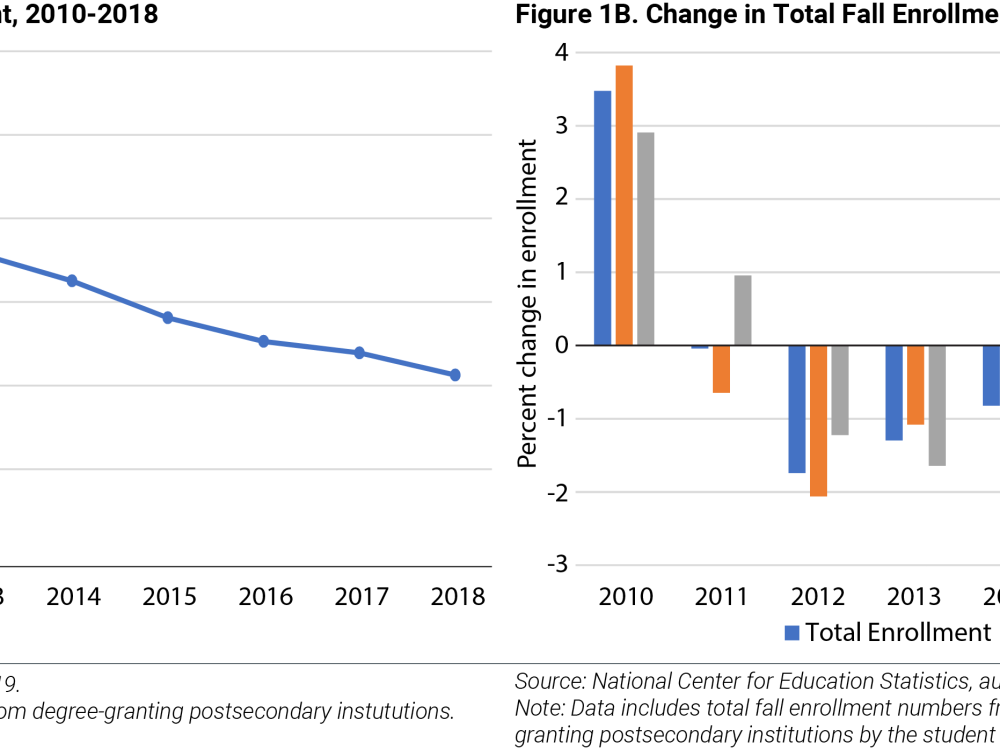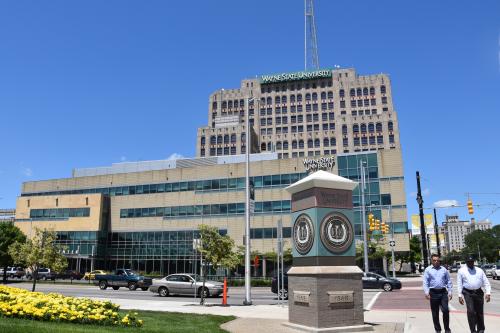This brief is part of the Brookings Blueprints for American Renewal & Prosperity project.
The pandemic has exacerbated the need for improvements in how we train and protect our workforce. Some of these needs are immediate, such as better worker health protections during the pandemic. Other needs are more longstanding but still urgent, such as equipping workers with the skills that will be demanded in the labor market in coming years. We propose three avenues to make progress along these lines. First, doing more to support the higher education sector in skills training. Second, focusing federal worker training programs on particular occupations and skills. And third, doing much more to support private-sector unions.
On all three fronts, enormous challenges were evident even prior to the pandemic. For example, for decades the higher education sector has faced significant declines in enrollment in the face of demographic changes and cuts in funding that could help to support necessary innovations. In addition, employer-paid and government-funded worker training have been on the decline for years. Finally, private-sector union membership has been declining for decades, meaning decreased support for on-the-job training and worker protections.
The pandemic has made the need for better worker training and protection more urgent and apparent, and recent policies have been insufficient to address these problems. COVID-19 has created significant and widely documented problems for higher education: enrollment has dropped, institutions have struggled to move classes online, and significant inequities in access to broadband and hardware have hampered students. Although federal actions – including the Families First Coronavirus Response Act Tax Credit and the Coronavirus Aid, Relief, and Economic Security (CARES) Act, both signed into law in March 2020 – provided some financial support, it has neither been sufficient nor effectively distributed. Moreover, the pandemic will accelerate trends toward automation, putting some skills in high demand and others in low demand, making the recovery in the labor market more difficult. As those changes and the ongoing pandemic put workers at risk, policies have done little to support private-sector unions.
We propose three sets of changes to help address these problems. First, in the area of higher education, the federal government should provide greater funding for institutions and ensure students’ access to broadband. Second, the federal government needs to implement policies that encourage the higher education system to support worker training by teaching skills valued by employers. And third, labor reforms can implement federal policies that would facilitate a move away from the current system of establishment-level bargaining and a move toward a sectoral bargaining system. These changes would increase worker coverage, provide higher wages and worker protection, reduce employee turnover, and provide more formal and informal opportunities for worker training.
Challenge
The COVID-19 pandemic exacerbated challenges for institutions of higher education, increased the need for workforce training, and increased the importance of workers’ rights to organize and bargain.
Higher education
Prior to the COVID-19 pandemic, the higher education sector faced challenges related to decreased enrollment and insufficient funds and training for online learning. The pandemic exacerbated the situation, costing colleges and universities billions of dollars, while also decreasing revenue opportunities.
Before the pandemic took hold, the higher education sector had already experienced a decrease of 1.3 million students since its enrollment peak in 2010 (National Center for Education Statistics). Figure 1A shows the decline in total fall enrollment in degree-granting postsecondary institutions between 2010 and 2018. Figure 1B shows the change in total fall enrollment by credit hour for full-time and part-time students. The decline in enrollment meant increased competition for qualified students, particularly for smaller, lower-resourced institutions (National Student Clearinghouse). The enrollment situation worsened in fall 2020 as many colleges and universities continued to offer a greater portion or all their courses online. Data from Davidson College’s College Crisis Initiative (C2i), shows that only 2.5 percent of colleges held classes fully in person during the fall 2020 semester. With tuition costs equal to face-to-face courses at a majority of schools, many students did not see the value in online courses and decided to take a gap year, postponing their higher education matriculation. In fall 2020 undergraduate enrollment declined four percent from a year earlier and first-time student enrollment decreased 13 percent nationwide (National Student Clearinghouse).

On March 6, the University of Washington became the first major university to cancel in-person classes and exams (Smalley, 2020). In the following days and weeks, universities across the country began closing their campuses, sending students home, and converting to online learning. That conversion was difficult and costly. While online learning had become increasingly popular prior to the pandemic, only a third of students at degree-granting postsecondary institutions in 2018 had taken at least one online course and less than five percent of college budgets had been dedicated to information technology spending (Leary, 2020; National Center for Education Statistics). Hence, many universities were unprepared for the transition to online learning during the spring 2020 semester as the pandemic began to spread and many students and faculty members had not received sufficient training to fully utilize online learning applications.
Ultimately the pandemic cost colleges and universities billions. The American Council on Education estimates the cost of lost revenue and of reopening campuses in the fall to be $120 billion (Inside Higher Ed). Refunds for unused housing and dining plans accounted for the bulk of revenue losses during the spring 2020 semester. Other sources of loss included lost revenues from athletic events and reductions in clinical income from university-affiliated hospitals. At the same time, those institutions incurred costs related to technology for online courses and—for in-person education—on protective equipment, social distancing accommodations, and COVID-19 testing (Schnell, 2020).
Alongside these financial and logistical challenges for the higher education sector, changes to the labor market will require institutions to change the way they prepare students for the future workforce. Prior to the COVID-19 pandemic, automation and artificial intelligence technologies were transforming the workplace, increasing interactions between workers and machines, and requiring new skills of workers (McKinsey, 2018). Autor and Reynolds (2020) speculate that the post-COVID labor market will markedly differ from its pre-pandemic environment in four key ways: telepresence, urban de-densification, employment concentration in large firms, and general automation forcing. Other studies have made similar predictions of how work will change in the wake of the COVID crisis. This will require significant steps forward in training our workers for the post-COVID-19 economy.
Significant disparities exist in institutions’ and students’ ability to face these challenges. The costs of overcoming them will be high for the majority of higher education institutions, but the challenges are magnified for Historically Black Colleges and Universities, minority-serving institutions, and small liberal arts institutions with lower endowment incomes and lower core revenues. In addition, the move to online education has only increased disparities in access to quality education. In particular, for low-income students and those who live in rural communities and lack internet access, remote learning is an additional barrier to education.
Worker training
Continuing workforce training has been inadequate for years. In a 2016 Pew Research survey, 35 percent of adults in the labor force said they did not currently have the education and training they need to get ahead. Among adults who cited needing more education or training to advance their careers, 57 percent said they couldn’t take time off work to get additional training, and 45 percent said they didn’t have access to or couldn’t afford the additional education needed (Pew Research). Additionally, employer-paid worker training has been on the decline. In particular, Waddoups (2016) found a 28 percent decline in employer-paid training between 2001 and 2009.
Government-funded worker training has not counteracted the decline in employer-provided training. In fact, government spending has declined in recent years. Moreover, the quality of government training varies, and it does not always encourage the type of training that is effective—training that incorporates employers’ and workers’ needs and is sector-based (Hanks and Madland, 2018). This lack of investment by both the government and employers corresponds with a decline in worker productivity and wages (Moss, Nunn, and Shambaugh 2020).
Many of the millions of workers who have been laid off during the pandemic will need to train for new jobs requiring new skills. In particular, the number of people who were laid off who reported that their previous jobs were permanently gone increased by 345,000 in September to 3.8 million, a 2.5 percent increase from February. Figure 2 shows permanent job losses between January 1994 and September 2020. In addition, the number of people who were long-term unemployed (jobless for 27 weeks or more) increased by 781,000 to 2.4 million (Bureau of Labor Statistics).
As mentioned above, a greater share of jobs in the future will likely require telepresence. In September, 23 percent of employed people teleworked because of the pandemic (Bureau of Labor Statistics). At the same time, Global Workplace Analytics estimates that 56 percent of the U.S. workforce holds a job that is compatible with remote work. The organization estimates that by the end of 2021, 25 to 30 percent of the workforce will be working from home multiple days a week.
The changes in the labor market will not be borne equally. An increase in telepresence would lead to reductions in office occupancy, commuting trips, and business travel. This will translate to decreased demand for workers in areas including cleaning, security, hotel workers, restaurant and cafeteria staff, taxi and ride-hailing drivers among others who provide services to highly educated, high wage workers. African American and Hispanic workers are overrepresented in these jobs. For example, compared to white workers, African American workers are over one-and-a half times more likely to be cashiers, cooks, and combined food preparation and serving workers (Broady, 2017).

Labor unions
According to data from the Bureau of Labor Statistics, the union membership rate (the percentage of wage and salary workers who were members of unions) has been declining for decades – decreasing from 20.1 percent in 1983 to 10.3 percent in 2019. The union membership rate of public-sector workers (33.6 percent) was more than five times higher than the rate for private-sector workers (6.2 percent). Private sector unionization rates remain varied across sectors. Protective service, education, training, and library occupations had the highest unionization rates, while the lowest rates were in farming, fishing, and forestry occupations (Bureau of Labor Statistics).
The decline in union membership was largely due to dips in unionization in public sector jobs (Roeder, 2020). In the June 2018 U.S. Supreme Court case, Janus v. American Federation of State, County, and Municipal Employees, the Court, in a 5-to-4 decision, ruled that it was unconstitutional to allow unions to require public employees to subsidize unions, even if they choose not to join and strongly object to the positions the union takes in collective bargaining and related activities. In a dissenting. The case overturned the ruling in Abood v. Detroit Board of Education, 431 U.S. 209 (1977), which allowed government entities to require public employees to pay a fair share of the cost that a union incurs when negotiating on their behalf over terms of employment, thereby cutting off a vital source of revenue for unions that represent government workers. In her dissent, Justice Kagan wrote the Court’s decision would “have large scale consequences,” and that “public employee unions will lose a secure source of financial support.” One year after the Janus decision, a report from POLITICO indicated that 10 large public-employee unions lost a combined 309,612 fee payers in 2018, but gained 132,212 members and all but one of these unions reported having more funds than they did the year before. Following Janus, public unions in 22 states and the District of Columbia that had allowed unions to collect agency fees from nonmembers lost union coverage for 115,625 employees (Rainey and Kullgren, 2019).
The decline in private sector union membership has partly been a result of federal laws that have actively discouraged private sector unions. In 1947 Section 14(b) of the Taft-Hartley Act gave individual states the right to outlaw union security provisions—provisions that establish a requirement that all or some workers must remain members of the union as an employment condition—and by 1965, twenty-one states prohibited such agreements. Right-to-work laws, currently enforced in twenty-seven states and Guam, allow workers the choice in union membership without the risk of losing employment (National Conference of State Legislature).

This decline in union membership has had negative economic consequences: wages have fallen and nonwage compensation (i.e., fringe benefits) has become less generous. Unions keep wages higher for nonunion workers because union agreements set wage standards and encourage managers to keep wages high to prevent workers from organizing and discourage their workers from leaving (Mishel, 2016). In 2014 median household incomes in right-to-work states were an average of $6,568 lower than in states where all workers in union-represented shops are required to pay an agency fee (Boyle and Hureaux, 2016). Further, the decline in union presence means fewer opportunities for worker training as historically unions were facilitators of on-the-job training, utilizing informal on-the-job learning as well as formalized apprenticeship programs.
In the COVID-19-era, a further consequence of decline in unions is that workers’ collective power is essential to promoting safety in the pandemic. Work from Celine McNicholas and Margaret Poydock shows that only 12 percent of essential workers, roughly one in eight, are covered by a union contract (McNicholas and Poydock, 2020). Without representation, those workers have a diminished ability to ensure their employers take action to keep them safe. From April 20 to August 20, COVID-19 related workplace safety complaints rose by 350 percent—many of these complaints were centered on the lack of access to adequate personal protective equipment (PPE) (O’Donnell, 2020). Daniel Schneider and Kristen Harknett found that only 19 percent of workers report having masks available in their workplace while 18 percent and seven percent reported wearing gloves or masks were mandatory, (Schneider and Harknett, 2020).
Limits of historic and existing policies
Although the COVID-19 pandemic has presented unique challenges to the systems of higher education, workforce training, and labor unions, many of the underlying issues are not new. In fact, policymakers at both the federal and state levels have been engaged in work to address these issues to varying degrees for some time. In this section, we will review some of the major initiatives in each of these areas and highlight some of their shortcomings.
Higher education
In recent decades, state money for higher education has declined, translating to lower funding for public college and university operations. Although increases in federal funding for student-based financial aid has provided indirect financial support for institutions, those increases have not directly funded spending on general operations. In particular, in 1990 per student funding by state governments was nearly 140 percent more than that provided by the federal government; but state funding per student was only 12 percent greater than federal funding per student in 2015 (Pew Research). Moreover, financial aid can be of limited use to students who need extensive remedial education (Education Commission of the States). Students enrolled solely in remedial programs are not considered to be enrolled in financial aid-eligible programs and are therefore not considered regular students (U.S. Department of Education). As a result, smaller financially strapped schools that are more likely to serve students who require remedial coursework have faced additional financial challenges.
With those existing challenges as the backdrop, the policies passed in the face of additional challenges brought about by the pandemic have been insufficient. The Coronavirus Aid, Relief, and Economic Security (CARES) Act enacted on March 27, 2020 established a $30.75 billion Education Stabilization Fund (Congressional Research Service). Of that, $14.3 billion was allocated to the Office of Postsecondary Education as the Higher Education Emergency Relief Fund to address needs directly related to COVID-19 including, but not limited to, transitioning courses to online platforms and grant aid to students for their educational costs such as food, housing, course materials, health care, and childcare, but it simply was not enough to cover the steep costs associated with the COVID-19 pandemic. The funds were allocated to schools based on a formula that prioritized institutions that serve full-time, low-income students receiving Pell Grants and required that at least half the funding go directly to students. Hence, 1,639 for-profit institutions received $1.1 billion in CARES Act funding, though they only serve eight percent of enrolled higher education students, while 89 of the 100 schools that received the least funds per student were not-for-profit, including 35 community colleges (Wilder, Sokolow, & Hao, 2020). When the 2020 National Survey of Access and Finance Issues asked 38 state directors of community colleges if CARES Act funding helped students in their state, 29 agreed, two were neutral and seven disagreed. Thirty-six respondents agreed that their state’s colleges had incurred significant unplanned technology and faculty/staff professional development and training costs to offer remote instruction. The respondents also agreed that the move to remote learning exposed differences in broadband access, especially in rural areas. Finally, 33 of 36 respondents agreed that additional funding is needed to support remote learning, faculty and staff development and counseling and advising (Education Policy Center, 2020).
Worker training
Historically, worker training programs have targeted the most disadvantaged workers or workers who are displaced by workplace changes. Some shortcomings of these policies were the result of the fragmented structure of training, while others resulted from the changing needs of workers. The Workforce Innovation and Opportunity Act of 2014 (WIOA) prepares unemployed job seekers who face significant barriers to employment. While the WIOA provided an improved outlook for job training following the Great Recession, its current policies are insufficient to meet the needs of the post-COVID workforce. In particular, only a small share of workers who need training to maintain their current job are covered under WIOA. Stronger provisions are needed to support both dislocated workers and current workers who need ongoing training.
Labor unions
The decline in union density over the last 40 years has been, in large part, the direct result of public policy decisions, both in the legislative and judicial systems. Some shortcomings were the result of initial failures in policy design, while others have been the result of more recent legislative and judicial limits placed on those New Deal-era laws.
An example of the former involves the original design of major U.S. labor laws—the National Labor Relations Act (NLRA) and the Fair Labor Standards Act (FLSA)—which excluded large swaths of workers from their protections, including agricultural workers, domestic workers, and independent contractors (National Labor Relations Board [NLRB] n.d.; U.S. Department of Labor n.d.). The result of this exclusion has been the undermining of workers’ ability to organize. Further, U.S. employers use a wide range of legal and illegal tactics to prevent workers from forming unions; employers are charged with violating federal law in 41.5 percent of all union election campaigns (McNicholas et al., 2019).
As mentioned above, a lack of union support has left workers without means to demand health protections in the COVID-19 pandemic. As a result, certain workers (whom we now realize are, and always have been, “essential”) have been put in dangerous working conditions (O’Donnell 2020; Sojourner and Yang 2020). The Occupational Safety and Health Act (OSHA), creates parameters for health and safety requirements in the workplace, but these COVID-19 safety parameters were left to individual employers for enforcement, leading to inconsistent protection for workers.
Policy recommendations
The primary goals of policymakers today must be addressing the public health crisis and getting the virus under control. In the meantime, the federal government must spend more on emergency measures—preferably set to phase out akin to automatic stabilizers triggered by economic conditions—to provide the necessary amount of relief to individuals, households, and firms facing the challenges brought on by the COVID-19 crisis. However, once the public health crisis is behind us, policymakers will be faced with an equally demanding challenge of rebuilding the U.S. economy. This will require significant steps forward in training our workers for the post-COVID-19 economy, which means that policymakers must enact reforms to our higher education institutions, workforce training systems, and collective bargaining structures.
Higher education
Institutions of higher education need additional government funding to improve online learning and ensure students’ access to laptops or tablets and broadband internet. In particular, the federal government should match state government funding for such investments by public higher education institutions. That would both increase federal funding and create greater incentives for state governments to increase their own funding of higher-education IT investments (Inside Higher Ed).
Higher education institutions can support the millions of unemployed workers seeking new kinds of jobs and the millions of employed workers seeing the nature of their work change. We propose that institutions focus on teaching these adult learners specific competencies (a competency being someone’s capability to apply a set of related knowledge, skills and abilities). For current workers, there are few ways to signal competencies to potential employers without some form of credential. Scott et al. (2020) suggest new efforts to build a competency-based system including increased transparency from colleges and universities about the competencies their programs impart and the labor-market outcomes those programs achieve.
Worker training
In addition, we propose reimagining how students can access classes focused on worker training. In a Hamilton Project dual-initiative proposal, Richard Arum and Mitchell Stevens propose the issuing of Learning Opportunity Credits (LOCs) from the federal government to all U.S. adults who are either unemployed or who receive the Earned Income Tax Credit (EITC) to promote ongoing workforce training as well as the expansion of high-quality hybrid learning opportunities. The second proposal would establish a national project on the Future of Learning, Opportunity, and Work (FLOW), a distributed collaboration between existing federal agencies and a network of competitively selected U.S. universities and their partners with the purpose of accumulating knowledge and informing policy on adult learning to serve the national interest moving forward (Arum and Stevens. 2020).
Labor unions
Despite the decades-long failure of labor law, there is reason for optimism: several academics, advocates, policymakers, and other stakeholders have put forward a menu of policy reforms—both at the state and federal level—that would go a long way to help restore union strength to workplaces. By extension, strong unions can provide workers with the necessary institutional support they need to prepare for the post-COVID economy.
For policymakers working to reverse the direction of labor law in this country, there are two paths available. The first, acknowledging the original sins and subsequent weakening of labor, involves a fundamental rethinking of labor-management relations in the United States. This approach is embodied by the innovative work being done by the Clean Slate for Worker Power Project, a project of Harvard Law School’s Labor and Worklife Program headed by Sharon Block and Benjamin Sachs. The project puts forward a plan for rewriting the rules that underpin labor law. For example, they suggest moving away from fundamental system establishment-level bargaining and instead moving toward a sectoral bargaining system, as already exists in Europe.
The second path forward is admittedly less bold in its imagination but nonetheless radical and transformative in its effects. It involves making changes to the labor law system while still operating within the existing framework (i.e., still fundamentally based on an establishment-level system or organizing and negotiating). A current legislative effort in this vein is the Protecting the Right to Organize Act (the PRO Act). The PRO Act would make it easier for workers to call and hold union elections; more severely penalize employers who violate existing labor laws; provide an easier pathway to obtaining a contract after winning recognition; protect the right to strike for union workers; and reverse the errors of the National Labor Relations Act (NLRA) by extending protections to previously excluded workers (e.g., independent contractors).
Conclusion
The COVID-19 pandemic has accelerated the need for improvements in higher education, worker training and protection, and labor unions. The policy solutions we propose would increase funding while also decreasing funding restrictions for higher education to more efficiently prepare students and workers for the post-COVID economy. Connections between employers and higher education institutions should serve to increase knowledge and transparency about the skills that will be required of future workers, encouraging colleges and universities to update their program offerings to meet workforce needs. But employers cannot expect the higher education system on its own to prepare future workers. Companies must make investments in worker training if they expect to find workers who possess the requisite knowledge and skills for currently available and future jobs. In addition to education and training, expanded union membership would serve to increase wages for union and non-union workers and provide a mechanism for workers to bargain collectively.







